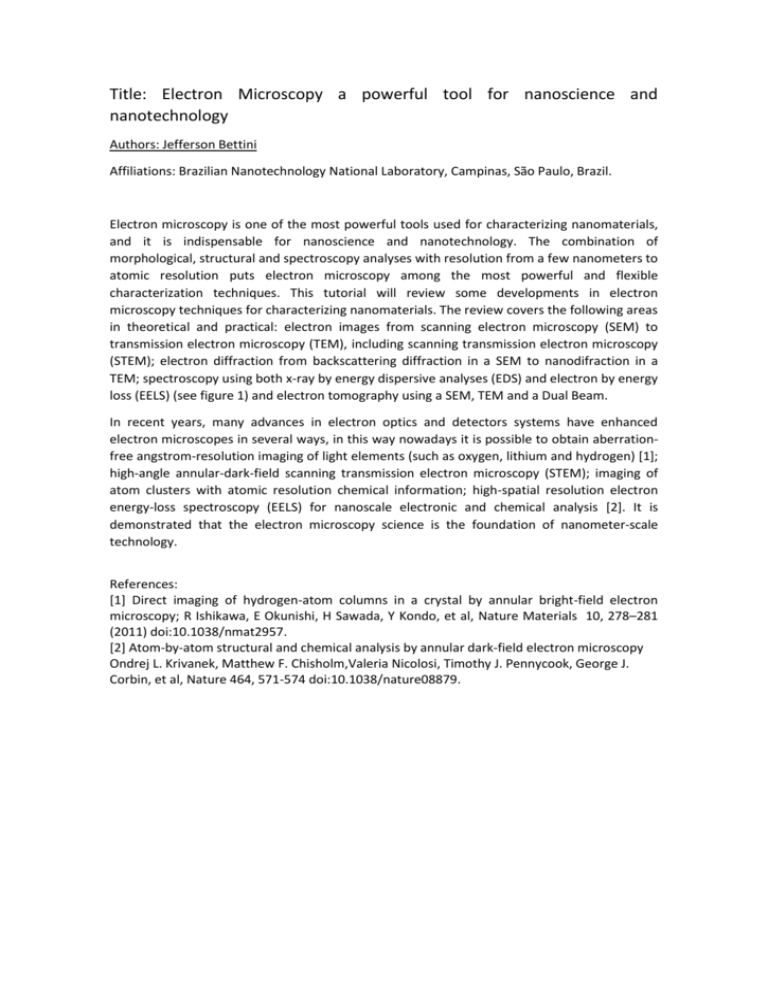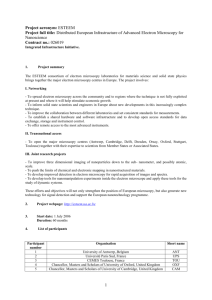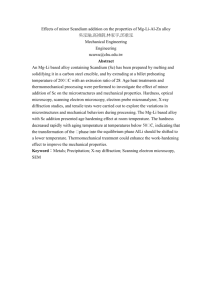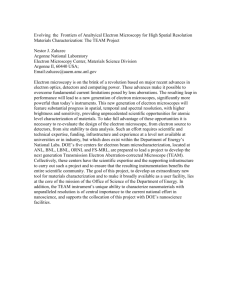Title: Electron Microscopy a powerful tool for nanoscience and
advertisement

Title: Electron Microscopy a powerful tool for nanoscience and nanotechnology Authors: Jefferson Bettini Affiliations: Brazilian Nanotechnology National Laboratory, Campinas, São Paulo, Brazil. Electron microscopy is one of the most powerful tools used for characterizing nanomaterials, and it is indispensable for nanoscience and nanotechnology. The combination of morphological, structural and spectroscopy analyses with resolution from a few nanometers to atomic resolution puts electron microscopy among the most powerful and flexible characterization techniques. This tutorial will review some developments in electron microscopy techniques for characterizing nanomaterials. The review covers the following areas in theoretical and practical: electron images from scanning electron microscopy (SEM) to transmission electron microscopy (TEM), including scanning transmission electron microscopy (STEM); electron diffraction from backscattering diffraction in a SEM to nanodifraction in a TEM; spectroscopy using both x-ray by energy dispersive analyses (EDS) and electron by energy loss (EELS) (see figure 1) and electron tomography using a SEM, TEM and a Dual Beam. In recent years, many advances in electron optics and detectors systems have enhanced electron microscopes in several ways, in this way nowadays it is possible to obtain aberrationfree angstrom-resolution imaging of light elements (such as oxygen, lithium and hydrogen) [1]; high-angle annular-dark-field scanning transmission electron microscopy (STEM); imaging of atom clusters with atomic resolution chemical information; high-spatial resolution electron energy-loss spectroscopy (EELS) for nanoscale electronic and chemical analysis [2]. It is demonstrated that the electron microscopy science is the foundation of nanometer-scale technology. References: [1] Direct imaging of hydrogen-atom columns in a crystal by annular bright-field electron microscopy; R Ishikawa, E Okunishi, H Sawada, Y Kondo, et al, Nature Materials 10, 278–281 (2011) doi:10.1038/nmat2957. [2] Atom-by-atom structural and chemical analysis by annular dark-field electron microscopy Ondrej L. Krivanek, Matthew F. Chisholm,Valeria Nicolosi, Timothy J. Pennycook, George J. Corbin, et al, Nature 464, 571-574 doi:10.1038/nature08879. Figures (maximum 2 figures). Figure 1. Chemical mapping by EELS where the green color corresponds to the Iron NanoRods and the red color the Cobalt NanoParticles before. a) and after annealing (b). O K edge (c) and Co L2,3 edge d) EELS spectra obtained by scanning a region containing only the NPs








